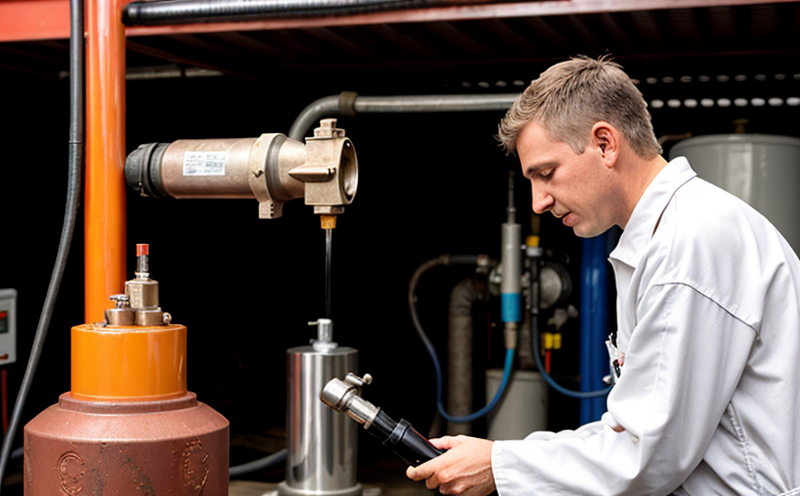ASTM D4809 Calorific Value Testing of Jet Fuel
The ASTM D4809 test method is a critical procedure in the aerospace and aviation industry, ensuring that jet fuel meets stringent quality standards. This testing ensures reliable performance during flight, which is crucial for safety and efficiency.
Jet fuel's calorific value refers to its ability to release energy when burned, and this property significantly impacts an aircraft’s range and payload capacity. Any deviation from the expected calorific value can lead to operational inefficiencies or even safety hazards. Therefore, accurate testing is paramount.
The ASTM D4809 method involves the use of a bomb calorimeter to measure the heat released by burning a known mass of fuel under controlled conditions. This process provides an accurate determination of the fuel's heating value on a higher heating value (HHV) basis, which is essential for aviation purposes.
For this test, we follow the standard procedure outlined in ASTM D4809, which specifies the use of a bomb calorimeter with a known heat capacity and an oxygen bomb. The sample jet fuel is ignited within the bomb, and the resulting heat released is measured accurately using calibrated thermocouples.
Preparation of the sample is critical to ensure accurate test results. The jet fuel must be free from contaminants such as water and particulates that could affect the calorific value measurement. Proper sampling techniques are employed to ensure a representative sample is tested.
The testing process involves several steps:
- Preparation of the sample jet fuel for testing, ensuring it is free from impurities.
- Loading the prepared sample into the oxygen bomb within the calorimeter.
- Performing a blank run to account for any background heat generated in the system.
- Igniting the sample and measuring the heat released accurately using calibrated thermocouples.
- Calculating the calorific value based on the heat measured, the bomb’s heat capacity, and other parameters as specified by ASTM D4809.
The results are reported in megajoules per kilogram (MJ/kg), providing a clear indication of the fuel's calorific value. This data is critical for aircraft operators to ensure that their fuel meets the required specifications, which can vary depending on the specific aircraft type and operational requirements.
Accurate calorific value testing ensures compliance with international standards such as ASTM D4809. These standards are crucial in maintaining safety and efficiency in aviation operations. By adhering to these standards, airlines and other aviation service providers can ensure that their fleet operates at optimal performance levels.
Scope and Methodology
The scope of ASTM D4809 calorific value testing is specifically focused on jet fuel. This test ensures that the fuel meets the required quality standards, which are essential for aviation operations. The methodology involves several key steps:
- Sample Preparation: Ensuring the sample is free from contaminants such as water and particulates.
- Bomb Calorimeter Setup: Using a calibrated bomb calorimeter with a known heat capacity.
- Safety Precautions: Implementing safety protocols to handle fuel samples safely, especially given the flammability of jet fuel.
- Blank Run: Conducting a blank run to account for any background heat generated during the testing process.
- Ignition and Measurement: Igniting the sample in the calorimeter and measuring the heat released using calibrated thermocouples.
The results of this test are used by quality managers, compliance officers, R&D engineers, and procurement teams to ensure that jet fuel meets the necessary standards. This ensures not only safety but also operational efficiency for airlines and other aviation service providers.
Quality and Reliability Assurance
- Calibration: Regular calibration of the bomb calorimeter to ensure accuracy in measurements.
- Safety Protocols: Strict adherence to safety protocols when handling flammable fuel samples.
- Data Verification: Cross-referencing results with other quality assurance checks to verify accuracy.
- Traceability: Maintaining a traceable record of all testing parameters and results for audit purposes.
We employ rigorous quality control measures throughout the testing process, ensuring that each test is conducted under controlled conditions and meets the highest standards. This approach not only enhances reliability but also builds trust with our clients in providing accurate and consistent results.
Competitive Advantage and Market Impact
Compliance with ASTM D4809 is essential for maintaining a competitive edge in the aviation industry. By ensuring that jet fuel meets these stringent standards, we help our clients achieve several key advantages:
- Safety: Ensuring safe and reliable aircraft performance.
- Efficiency: Maximizing the range and payload capacity of aircraft by optimizing fuel usage.
- Regulatory Compliance: Meeting international standards and regulations, reducing the risk of penalties or operational disruptions.
In today’s competitive market, where airlines are constantly seeking to reduce costs while maintaining high safety standards, our services provide a critical edge. By ensuring that fuel meets these stringent quality standards, we help clients stay ahead of the curve in terms of both safety and efficiency.





